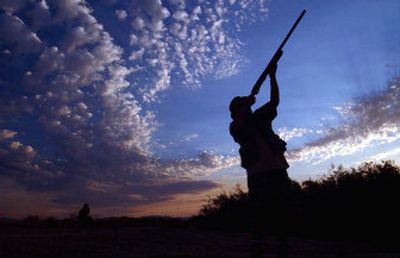Better than ever

Editor’s note: The last of the Inland Northwest’s brief fall dove hunting seasons closed last week. Farther south, however, dove hunting is a way of life.
ABASOLO, Mexico — Dove hunting in Mexico is a sensory overload, a wing-shooting fiesta.
Thanks to an agriculture explosion, white-winged doves are more plentiful today than 50 years ago, at least in the Mexican state of Tamaulipas, across the Rio Grande from Brownsville, Texas.
Gary Waggerman, a retired biologist for Texas Parks and Wildlife, spent most of his career studying whitewings in Mexico and Texas. It was the green revolution of the early 1970s, Waggerman said, that greatly increased Tamaulipas whitewing numbers.
“The farmers cleared thousands of acres of brush and planted the fields in grain,” he said.
“There was plenty of brush left for nesting and roosting, and the grain crops increased the amount of food available to birds. There may have only been 5 or 6 million whitewings in Tamaulipas in the 1950s. We don’t know how many are there today, but it could be 15 to 18 million. Some of the nesting colonies have 5 million birds.”
I was hunting with Rancho Caracol, an operation about 15 miles south of the border and owned by Barry Putegnat Jr. and run by his son, Dean. The Putegnat family grew up in the Rio Grande Valley. Three generations of Putegnats have roamed back and forth across the Rio Grande, treating the international boundary with no more respect than they treated the Nueces River to their east.
As teenagers, David and brother Barry Jr. often crossed into Mexico by themselves, hunting the abundant doves, quail and waterfowl after school. “We’d pack an ice chest with tortillas, avocados, peppers and cilantro and cook doves in the field,” David said. “It was a great life.”
Those days are over. Modern laws are strict about transporting guns and ammunition across the border, I wouldn’t attempt to hunt in Mexico without the help of a first-class outfitter.
About 60 percent of Ranch Caracol’s whitewing hunters are from Texas.
The issue of safety from drug-related violence in some areas of Mexico spawned a shopping list of questions from Frankie Brooks of Celina, Texas, when she called the outfitter’s office to book a hunting trip for her husband’s 70th birthday. Satisfied that her husband, Larry, would be safe, she figured he would enjoy the experience more if their son, Steve, accompanied him.
“It’s every bit as good as we expected it to be,” said Steve Brooks as he guarded a waterhole against incoming whitewings. He was positioned just 100 yards from his dad’s stand and got to watch while his father, a veteran at International skeet, put on a shooting clinic. “This is the first time we’ve hunted in Mexico, but it won’t be the last.”
One way outfitters streamline the border crossing process is by maintaining an inventory of shotguns at the lodge. Hunters no longer have to buy a gun permit to transport their own shotguns, and they don’t stop at every military checkpoint while soldiers check the serial numbers against the paperwork.
Rancho Caracol’s gun room is stocked with Beretta over-unders and autoloaders in 20 and 12 gauge.
“We’re in the hunting business,” Dean Putegnat said, “but we’re really in the entertainment business. There’s no place in North America where you can see this many birds and enjoy this volume of shooting.”